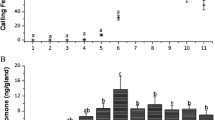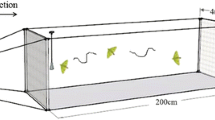Abstract
The calling behaviour of virgin females Condylorrhiza vestigialis Guenée, 1854 (Lepidoptera: Crambidae) and the female pheromone gland extract activity were studied under laboratory conditions. Most of the females started calling from their first scotophase period after emergence. Maximum calling occurred between the seventh and tenth hours of the scotophase period. The length of the calling increased with age until the fourth scotophase, but the onset of calling time did not differ with age. The number of calling bouts increased significantly with age, but the mean duration of each calling bout (20.8 min) did not vary with age. Extracts of pheromone glands evaluated in a Y-tube olfactometer attracted significantly more males than control, 70 and 30%, respectively. Gas chromatographic–electroantennogram detection (GC–EAD) analysis of these extracts indicated the presence of a single EAD-active peak, the putative sex pheromone of the species. This pheromone compound may be suitable for monitoring populations densities of C. vestigialis, and for detection of the onset of the seasonal flight period. An efficient pheromone is of importance also with respect to current attempts to develop new control methods for this important pest of Populus spp. in Brazil.



Similar content being viewed by others
References
Ambrogi BG, Zarbin PHG (2008) Aggregation pheromone in Sternechus subsignatus (Coleoptera: Curculionidae): olfactory behaviour and temporal pattern of emission. J Appl Entomol 132:54–58
Arn H, Tóth M, Priesner E (2000) The pherolist http:www.nysaes.cornell.edu/pheronet
Ayres M, Ayres M Jr, Ayres DL, Santos AS (2003) BioEstat 3.0 Aplicações estatísticas nas áreas das ciências biológicas e médicas. Sociedade Civil Mamirauá, Belém
Babilis NA, Mazomenos BE (1992) Pheromone production in Sesamia nonagrioides: diel periodicity and effect of age and mating. J Insect Physiol 38:561–564
Batista-Pereira LG, Wilcken CF, Pereira Neto SD, Marques EN (2004) Comportamento de chamamento de Thyrinteina arnobia (Stoll) (Lepidoptera: Geometridae) em Psidium guajava, Eucalyptus grandis e em dieta artificial. Neotrop Entomol 33:21–28
Biddinger DJ, Feland CM, Hull LA (1994) Parasitism of tufted apple bud moth (Lepidoptera: Tortricidae) in conventional insecticide and pheromone-treated Pennsylvania apple orchards. Environ Entomol 23:1568–1579
Cardé RT, Minks AK (1997) Insect pheromone research: new directions. Chapman and Hall, New York
Cardé RT, Roelofs WF (1973) Temperature modification of the male sex pheromone response and factors affecting female calling in Holomelina immaculata (Lepidoptera: Arctiidae). Can Entomol 105:1505–1512
Castro MEB, Santos ACB, Ribeiro ZMA, Souza ML, Sousa NJ (2004) Análise de proteínas estruturais e de DNA do baculovirus Condylorrhiza vestigialis nucleopolyhedrovirus. Embrapa Recursos Genéticos e Biotecnologia. Comunicado Técnico, p 62
Corrêa FASF (2006) Criação em laboratório de Condylorrhiza vestigialis (Guenée, 1854) (Lepidoptera: Crambidae) com diferentes dietas artificiais. MD dissertation. Universidade Federal do Paraná, Curitiba, Brasil
Delisle J, Royer L (1994) Changes in pheromone titer of oblique-banded leafroller, Choristoneura rosaceana, virgin females as a function of time of day, age; temperature. J Chem Ecol 20:45–69
Eiras AE (2000) Calling behavior and evaluation of sex pheromone glands extract of Neoleucinodes elegantalis Guenée (Lepidoptera: Crambidae) in wind tunnel. An Soc Entomol Brasil 29:453–460
Epstein DL, Zack RS, Brunner JF, Gut L, Brown JJ (2000) Effects of broad-spectrum insecticides on epigeal arthropod biodiversity in pacific Northwest apple orchards. Environ Entomol 29:340–348
Gómez VRC, Rojas JC (2006) Calling behavior of Zamagiria dixolophella (Lepidoptera: Pyralidae). Fla Entomol 89:83–84
Hou ML, Sheng CF (2000) Calling behaviour of adult female Helicoverpa armigera (Hubner) (Lep., Noctuidae) of overwintering generation and effects of mating. J Appl Entomol 124:71–75
Howlader MA, Gerber GH (1986) Calling behavior of the bertha armyworm, Mamestra configurata (Lepidoptera: Noctuidae). Can Entomol 118:735–743
Kamimura M, Tatsuki S (1993) Diel rhythms of calling behavior and pheromone production of oriental tobacco budworm moth, Helicoverpa assulta (Lepidoptera: Noctuidae). J Chem Ecol 19:2953–2963
Kanno H (1979) Effects of age on calling behavior of the rice stem border, Chilo suppressalis (Walker) (Lepidoptera: Pyralidae). Bull Entomol Res 69:331–335
Kingan TG, Thomas-Laemont PA, Raina AK (1993) Male accessory gland factors elicit change from ‘virgin’ to ‘mated’ behavior in the female corn earworm moth Helicoverpa zea. J Exp Biol 183:61–76
Leal WS, Mochizuki F, Wakamura S, Yasuda T (1992) Eletroantennografic detection of Anomala cuprea sex pheromone. Appl Entomol Zool 27:289–291
Leal WS, Kawamura F, Ono M (1994) The scarab beetle Anomala albopilosa sakishimana utilizes the same sex pheromone blend as a closely related and geographically isolated species, Anomala cuprea. J Chem Ecol 20:1667–1676
Leal WS, Oehlschlager AC, Zarbin PHG, Hidalgo E, Shannon P, Murata Y, Gonzalez L, Andrade R, Ono M (2003) Sex pheromone of the scarab beetle Phyllophaga elenans and some intriguing minor components. J Chem Ecol 29:15–25
Linn CE Jr, Campbell MG, Roelofs WL (1986) Male moth sensivity to multicomponent pheromones: critical role of female-released blend in determining the functional role of components and active space of the pheromone. J Chem Ecol 12:659–668
Mazo-Cancino A, Malo EA, Cruz-López L, Rojas JC (2004) Diel periodicity and influence of age and mating on female sex pheromone titre in Estigmene acrea (Lep., Arctiidae). J Appl Entomol 128:459–463
Parra-Pedrazzoli AL, Cossé A, Murata Y, Bento JMS, Vilela EF, Leal WS (2006) Towards the identification and synthesis of the sex pheromone of the citrus leafminer, Phyllocnistis citrella Stainton (Lepidoptera: Gracillariidae). Neotrop Entomol 35:12–18
Roelofs WL, Cardé RT (1987) Responses of Lepidoptera to synthetic sex pheromone chemicals and their analogues. Annu Rev Entomol 22:377–405
Rojas JC, Cibrián-Tovar J (1994) Calling behavior of Copitarsia consueta (Lepidoptera: Noctuidae). Fla Entomol 77:178–180
Silva EL, Carvalho CM, Nascimento RR, Mendonça AL, Silva CF, Gonçalves GB, Freitas MRT, Sant’Ana APG (2006) Reproductive behaviour of the Annona fruit borer, Cerconota anonella. Ethology 112:971–976
Swier SR, Rings RW, Musick GJ (1977) Age-related behavior of the black cutworm, Agrotis ipsilon. Ann Entomol Soc Am 70:919–924
Trefflich K, Sousa NJ (2000) Eficiência de três produtos químicos para o controle de Condylorrhiza vestigialis Guenée, 1854 (Lepidoptera–Pyralidae). In: Sanqueta CR (ed) Seminário de Atualidades em Proteção Florestal. FUPEF, Curitiba, p 182
Turgeon J, Mcneil J (1982) Calling behavior of the armyworm Pseudaletia unipuncta. Entomol Exp Appl 31:402–408
West RJ, Teal PEA, Laing JE, Grant GM (1984) Calling behavior of the potato stem borer, Hydraecia micacea Esper (Lepidoptera: Noctuidae) in the laboratory and in the field. Environ Entomol 13:1399–1404
Witzgall P, Chambon J-P, Bengtsson M, Unelius CR, Appelgren M, Makranczy G, Muraleedharan N, Reed DW, Hellrigl K, Buser H-R, Hallberg E, Bergström G, Tóth M, Löfsted C, Löfqvist J (1996) Sex pheromones and attractants in the Eucosmini and Grapholitini (Lepidoptera, Tortricidae). Chemoecology 7:13–23
Zarbin PHG, Arrigoni EB, Reckziegel A, Moreira JA, Baraldi PT, Vieira PC (2003) Identification of male-specific chiral compound from the sugarcane weevil Sphenophorus levis. J Chem Ecol 29:377–386
Zarbin PHG, Moreira MAB, Haftmann J, Francke W, Oliveira ARM (2007a) Male-specific volatiles released by the Brazilian papaya weevil, Pseudopiazurus obesus: Partial identification and evidence of an aggregation pheromone. J Braz Chem Soc 18:1048–1053
Zarbin PHG, Lorini LM, Ambrogi BG, Vidal DM, Lima ER (2007b) Sex pheromone of Lonomia obliqua: daily rhythm of production, identification and synthesis. J Chem Ecol 33:555–565
Acknowledgments
We thank Leandro Sousa-Souto and Andrés González Ritzel for their valuable suggestions. This research was supported by Conselho Nacional de Desenvolvimento Científico e Tecnológico (CNPq), International Foundation for Science (IFS), Sweden, Organization for the Prohibition of Chemicals Weapons, The Netherlands, Fundação Araucária, and CAPES.
Author information
Authors and Affiliations
Corresponding author
Additional information
Communicated by A. Battisti.
Rights and permissions
About this article
Cite this article
Ambrogi, B.G., Fonseca, M.G., Coracini, M.D.A. et al. Calling behaviour and male response towards sex pheromone of poplar moth Condylorrhiza vestigialis (Lepidoptera: Crambidae). J Pest Sci 82, 55–60 (2009). https://doi.org/10.1007/s10340-008-0219-8
Received:
Revised:
Accepted:
Published:
Issue Date:
DOI: https://doi.org/10.1007/s10340-008-0219-8




